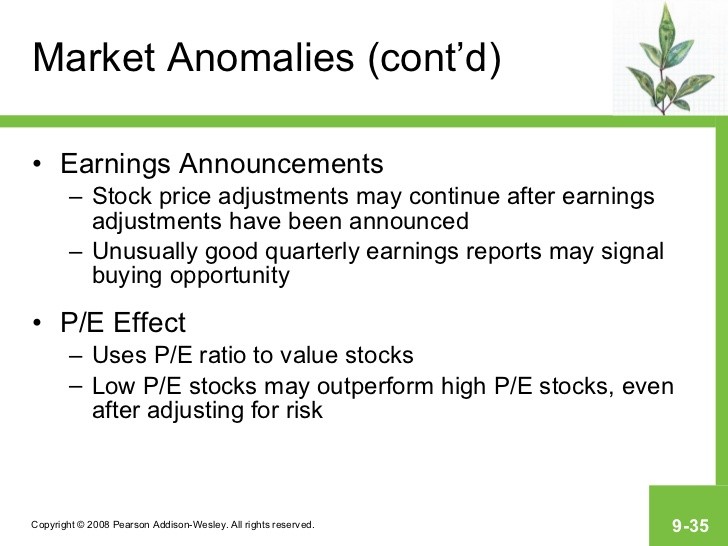The Best of Behavioral Finance Anomalies
Post on: 12 Июль, 2015 No Comment

And before I go, my two favorite Behavioral Finance anomalies. Learn them, because next time someone tells you that the market is perfectly efficient all the time, bring these up.
This paper investigates the response of option market investors to the information contained in daily changes in the instantaneous variance of the underlying asset. Evidence is provided that these investors exhibit (1) short-horizon underreaction to daily information, (2) long-horizon overreaction to extended periods of mostly similar daily information, and (3) increasing misreaction (along a scale that ascends from underreaction to overreaction) to daily information as a function of the quantity of previous similar information. The increasing misreaction can reconcile the short-horizon underreaction with the long-horizon overreaction and is also consistent with well-established cognitive biases.
The behavioral cues related to overreaction and underreaction that we know show up in the stock market also show up in the options market. Why is this important? Because as opposed to the stock market, option traders are looking at one variable, the volatility, and trying to estimate it. Instead of a mix of P/E ratios and the whole mess of problems with equity valuation, options have one free variable, the volatility, and options traders have the same behavioral cues when they estimate it.
Also the market is dominated by professional investors. This isnt the I heard on the television to buy crowd. These are people who know the market, and know that there are behavioral cues. Also the market is highly liquid, which removes one of those problems in trying to figure out if behavioral ticks in equities markets are the result of market imperfections.
So isolated down, to a professional, highly-paid investor in a highly liquid market looking at one single variable volatility we still see behavioral over/under-reaction. Score that for the behavioral crew.
How do investors respond to predictable shifts in profitability? We consider how demographic shifts affect profits and returns across industries. Cohort size fluctuations produce forecastable demand changes for age-sensitive sectors, such as toys, bicycles, beer, life insurance, and nursing homes. These demand changes are predictable once a specific cohort is born. We use lagged consumption and demographic data to forecast future consumption demand growth induced by changes in age structure. We find that demand forecasts predict profitability by industry. Moreover, forecast demand changes five to ten years in the future predict annual industry stock returns. One additional percentage point of annualized demand growth due to demographics predicts a 5 to 10 percentage point increase in annual abnormal industry stock returns. However, forecasted demand changes over shorter horizons do not predict stock returns. A trading strategy exploiting demographic information earns an annualized risk-adjusted return of approximately 6 percent. We present a model of inattention to information about the distant future that is consistent with the findings. We also discuss alternative explanations, including omitted risk-based factors.
So whats going on here? If you ask financial analysts, they may tell you that they are trying to get it right 3 to 5 years out. If you ask a EMH guy, theyd say thats impossible, markets have to be correct for all time, since they reflect all available information. So if there was going to be a predictable demand for a good 10 years out, the market should have already priced that.
How do we test that? In this paper, DellaVigna and Pollet took on the Herculean statistical task of looking at demographic groups as they age, using birth rates and life expectancy rates, and comparing that with predicted demand for goods/services across years, and see when the market realizes that these groups are going to start consuming toys for their children, nursing homes for the elderly, etc. They found that the market gets this right, but only about 3 to 5 years out. Past that point, the market ignores it.
Why? People and institutions have time and attention constraints. Perhaps people also dont want to get rewarded for something that wont happen for 10 years, when they may be at another job (or already denied the promotion that occurs every 3 years).
The problem is that things that may not happen for another 6 years are off the radar theres more immediate important and profitable stuff to deal with in the here and now. 6 years is a terribly long time in the finance world to sit and wait to weed out inefficiencies (there are limits to arbitrage!), though if they involve huge risks, say a nation-wide housing bubble, it isnt clear that the market will be able to think through the effect of their actions 10 years down the line.
So check them out both fantastic papers. What are you favorites?














